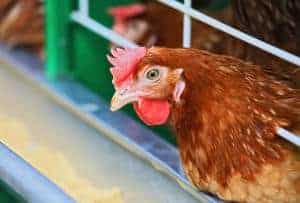A 73-year-old woman in Jiangxi province in China has died from an H10N8 avian flu infection, Hong Kong’s Centre for Health Protection (CHP) said today, the first report of that strain infecting humans.
The woman, whose immune system was compromised, had an underlying illness and had visited a live-poultry market, CHP reported in a statement. She was admitted to a local hospital on Nov 30, was diagnosed as having severe pneumonia, and died Dec 6.
China’s National Health and Family Planning Commission confirmed the case. The woman’s close contacts are under medical surveillance but have as yet remained asymptomatic.
“Influenza A(H10) is currently not a local statutorily notifiable infectious disease but the Public Health Laboratory Services Branch of the CHP is capable of detecting this virus by culture or genetic testing. No confirmed human cases have been recorded so far in Hong Kong,” a spokesman for the CHP said in the statement.
David Halvorson, DVM, an avian health expert at the University of Minnesota in St. Paul, told CIDRAP News, “I am unaware of any [previous] H10N8 human infections.”
The CHP said in the statement that it will follow up with the World Health Organization (WHO) and health officials on the mainland for more information. Meanwhile, Hong Kong authorities have stepped up surveillance efforts.
The CHP spokesman urged travelers not to visit live-poultry markets and avoid direct contact with poultry, birds, and their droppings. Jiangxi is located in southeastern China, with only Guangdong province separating it from Hong Kong.
H10N8 in birds; previous H10 human cases
The H10N8 strain has been detected in Chinese birds. In June 2012 in the Journal of Virology, Chinese researchers reported its first detection in a live-bird market, in Guangdong province.
In January 2011 in Virology Journal, a different group of investigators reported that H10N8 had been isolated from a water sample taken from Dongting Lake in 2007. The lake is in Hunan province, which borders both Jiangxi and Guangdong provinces.
They reported that the isolate was lowly pathogenic for chickens but replicated efficiently in the mouse lung. They also noted rapidly increasing virulence in mice as the virus adapted to the mouse lung.
Although this is the first confirmed case of H10N8 in a person, a May 2012 report in Emerging Infectious Diseases noted that two Australian abattoir workers tested positive for H10 after they processed chickens from a farm that had had an H10N7 outbreak in 2010. They had only minor symptoms.
H10N7 was also detected in two Egyptian infants in 2004.
Global H5N1 count: 648 cases
In other avian flu news, the WHO yesterday confirmed seven H5N1 avian flu cases that were reported by local health authorities in the past 2 months, six in Cambodia and one in Indonesia. They bring the official global H5N1 count to 648 cases, including 384 deaths—a 59% case-fatality rate (CFR).
The Indonesian H5N1 patient died, as did three of the Cambodian patients. The Indonesian case was the most recently reported, on Nov 18. The WHO’s previous report on flu at the human-animal interface was Oct 7. Although the latest update was posted yesterday, it is dated Dec 10.
The agency highlighted the dramatic upturn in H5N1 cases in Cambodia this year. After confirming 21 cases from 2005 through 2012, the country has had 26 cases in 2013. “This might be due to improvements in surveillance and physician awareness or to a potential increased circulation of the virus in poultry,” the WHO said.
The agency pointed out, though, that Cambodia’s H5N1 CFR dropped from 90% in previous years to 54% in 2013.
The WHO also noted a shift in H5N1 clade—or subtype—in Cambodia this year. Before 2013, clade 1.1 dominated. But since early 2013 a new clade emerged that represents a reassortment of clade 1.1 and clade 2.3.2.1 in both people and birds. “The link between the emergence of this reassortant virus and the increase in human cases observed in 2013 is yet to be determined,” the agency said.
Increased surveillance in China
 The WHO report also noted increased awareness of avian flu throughout China and an expectation that more cases of novel H7N9 avian flu—which was first reported in the spring—and of H5N1 may occur.
The WHO report also noted increased awareness of avian flu throughout China and an expectation that more cases of novel H7N9 avian flu—which was first reported in the spring—and of H5N1 may occur.
“Owing in part to the emergence of avian influenza A(H7N9) virus and infections of humans with this virus in China, there is enhanced surveillance for various subtypes of avian influenza in both humans and animals in China, the countries neighbouring China, and globally,” the update states.
“It is therefore expected that more influenza A(H5N1) and A(H7N9) events in humans and animals will be detected and reported, as well as identification and reporting of infections with a variety of other influenza subtypes and reassortant viruses.”



